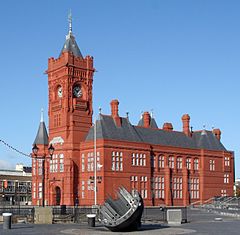Pierhead Building
| Pierhead Building | |
|---|---|
| Adeilad y Pierhead | |
 |
|
| General information | |
| Architectural style | French Gothic Renaissance |
| Location | Cardiff, Wales |
| Town or city | Cardiff |
| Country | Wales |
| Coordinates | 51°27′49″N 3°09′48″W / 51.463539°N 3.163389°W |
| Inaugurated | 1897 |
| Design and construction | |
| Architect | William Frame |
| Website | |
| pierhead.org | |
The Pierhead Building (Welsh: Adeilad y Pierhead) is a Grade I listed building of the National Assembly for Wales in Cardiff Bay, Wales. It stands as one of the city of Cardiff's most familiar landmarks and was built in 1897 as the headquarters for the Bute Dock Company.
The clock on the building is unofficially known as the "Baby Big Ben" or the "Big Ben of Wales", and also serves as a Welsh history museum. The Pierhead Building is part of the estate of the National Assembly for Wales, which also includes the Senedd and Ty Hywel.
The Grade One listed building was built in 1897 and designed by the English architectWilliam Frame. It was a replacement for the headquarters of the Bute Dock Company which burnt down in 1892. Frame's mentor was William Burges, with whom Frame worked on the rebuilding of Cardiff Castle and Castell Coch until Burges's death in 1881.
The Bute Dock Company was renamed the Cardiff Railway Company in 1897. A coat of arms on the building's façade bears the company's motto "wrth ddŵr a thân" (by water and fire) encapsulating the elements creating the steam power which transformed Wales.
The Pierhead became the administrative office for the Port of Cardiff in 1947.
The 1897 clock mechanism, by William Potts & Sons of Leeds, was removed, being replaced with an electronic motor, and auctioned off by British Rail and sold to an American collector in 1973. It was returned to Cardiff in 2005 and, in 2011 was restored by Smith of Derby Group and installed as a piece of contemporary art created by artist Marianne Forrest in Cardiff city centre.
...
Wikipedia
